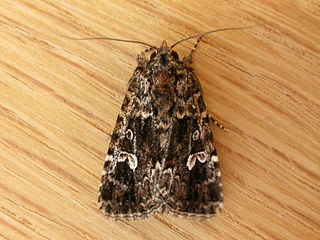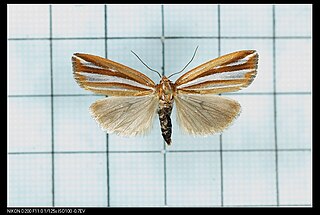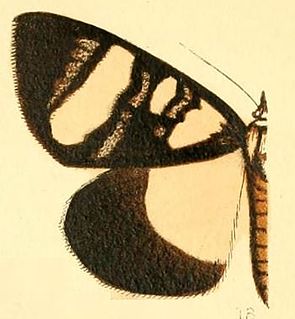Asteropetes is a monotypic moth genus of the family Noctuidae erected by George Hampson in 1901. Its only species, Asteropetes noctuina, was first described by Arthur Gardiner Butler in 1878. It is found on the Kuriles and in Japan.
Cremnophora is a monotypic moth genus of the family Noctuidae erected by George Hampson in 1901. Its only species, Cremnophora angasii, was first described by George French Angas in 1847. It is found in South Australia.

Ectopatria is a genus of moths of the family Noctuidae. The genus was erected by George Hampson in 1903.

Eutrichopidia is a genus of moths of the family Noctuidae. The genus was erected by George Hampson in 1901.

Loxioda is a genus of moths of the family Erebidae. The genus was described by Warren in 1913.

Narangodes is a genus of moths of the family Noctuidae. The genus was erected by George Hampson in 1910.
Neocerynea is a monotypic moth genus of the family Noctuidae erected by George Hampson in 1918. Its only species, Neocerynea sabulosa, was first described by Schaus in 1901. It is found in Mexico.

Omphaloceps is a genus of moths of the family Noctuidae. The genus was erected by George Hampson in 1901.
Orsa is a genus of moths of the family Erebidae. The genus was erected by Francis Walker in 1865.
Paraegocera is a genus of moths of the family Noctuidae. The genus was erected by George Hampson in 1901.
Parothria is a monotypic moth genus of the family Noctuidae erected by George Hampson in 1901. Its only species, Parothria ecuadorina, was first described by John O. Westwood in 1877. It is found in Ecuador.
Phasidia is a monotypic moth genus of the family Noctuidae erected by George Hampson in 1901. Its only species, Phasidia contraria, was first described by Francis Walker in 1865. It is found in Peru and the Brazilian state of Rio de Janeiro.

Platyja is a genus of moths of the family Erebidae erected by Jacob Hübner in 1823.
Polacanthopoda is a genus of moths of the family Noctuidae. The genus was erected by George Hampson in 1901
Pseudbarydia is a genus of moths of the family Erebidae. The genus was erected by George Hampson in 1924.
Pseudophisma is a genus of moths of the family Erebidae. The genus was erected by George Hampson in 1926.
Renodes is a genus of moths in the family Erebidae. The genus was erected by Achille Guenée in 1852.
Sanys is a genus of moths of the family Erebidae. The genus was erected by Achille Guenée in 1852.
Schalifrontia is a monotypic moth genus of the family Noctuidae. Its only species, Schalifrontia furcifer, is found in the Brazilian state of Santa Catarina. Both the genus and species were first described by George Hampson in 1901.
Heosphora is a genus of moths in the family Pyralidae. The genus was first described by Edward Meyrick in 1882. The type species is Anerastia psamathella Meyrick, 1879, designated as such by George Hampson in 1901. All Heosphora species are found in Australia.






